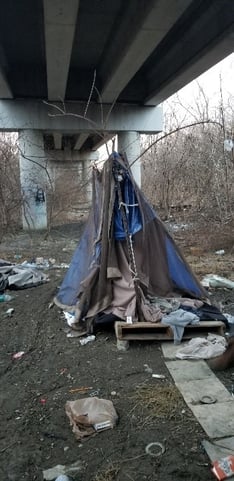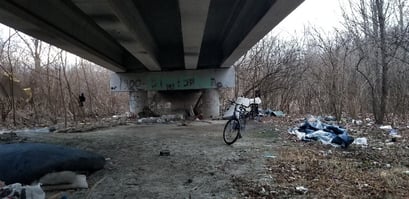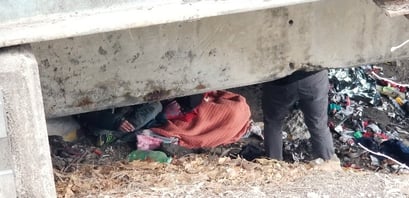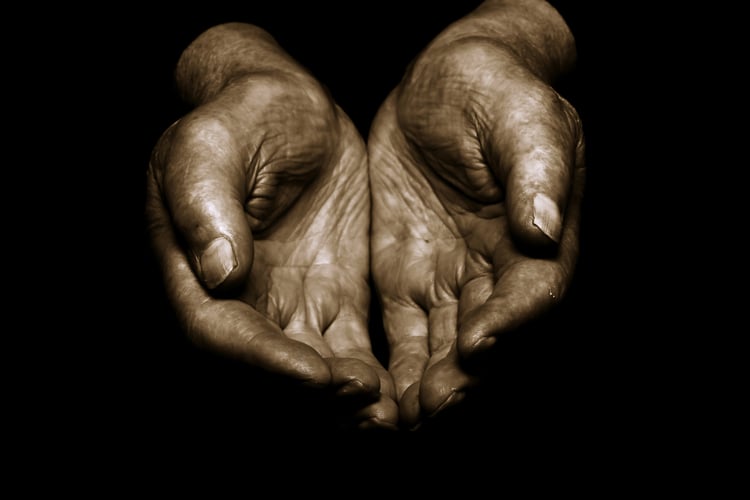Each year, KHC and our partners conduct the K-Count, an annual count of homeless adults and families across the state, to monitor the homeless situation in Kentucky.
Third-World Conditions in a Twenty-First Century America
Each year, KHC and our partners conduct the K-Count, an annual count of homeless adults and families across the state, to monitor the homeless situation in Kentucky. The U.S. Department of Housing and Urban Development (HUD) requires this count to demonstrate the need for resources for housing and services for homeless persons in each community. This year, I thought it would be beneficial to participate in the K-Count, to actually search for and talk with those who found themselves homeless. I would like to thank the staff of Welcome House of Northern Kentucky for allowing me to participate in their count, and the Emergency Shelter of Northern Kentucky for allowing me to visit their facility. My experience left me heartbroken, hopeful, and determined.



We began along a railroad track in the cold, dark, early morning. One of the volunteers with us used to be on the other side of the K-Count and came ready to give hope to the hopeless. As we shined our flashlights on tarps and tents of a homeless camp, I became more thankful for the warm bed I rolled out of a couple of hours earlier. I hoped that we wouldn’t find anyone frozen to death in the cold, dilapidated tents. The tents had varying degrees of intricacy. Some were tarps laid over a few sticks and cold dirt, while others had walls made of scrap wood, wooden pallets for a bed, and wadded-up clothes for a pillow. One tent had a couch by it in what appeared to be a makeshift living area with pictures of whom I assumed were loved ones. Surrounding trees were lined with frozen sweatshirts and jeans that had been hung out to dry.

One gentleman we spoke with lived under a bridge and said he had been living on the streets for more than a decade. As we completed the survey with him, he mentioned mental health issues that he has dealt with for years. As I climbed up from underneath the bridge, I noticed a couple of used syringes and cautiously stepped over them. Little orange caps from used needles were a familiar sight in the places we visited.
We stopped to speak with a young man in his early twenties who was walking alongside a busy highway. He was reluctant to talk with us at first, but was less hesitant after we offered him a pair of gloves. While telling us about his struggle with epilepsy and how he was kicked out of his home, his eyes began to tear up. One of our group leaders wrapped her arms around him. Often, homeless people are dehumanized and are treated as if they are invisible. As the old Irish proverb reminds us that, “It is in the shelter of each other that people live.”
Another man told me about his past drug addiction and his fight to get sober. He was candid as he told me that he was responsible for his drug problems, and that he was responsible for getting himself out of his problems. Working two jobs, one at a fast food restaurant and another at a local mechanic’s shop, he had been living in and out of a homeless shelter for several weeks. Finding housing was difficult because of his prior drug charges. By the time he clocked out of his second job, he struggled to make it to the homeless shelter line in time to get a bed for the night due to overcrowding at the shelter.
I was heartbroken to see the third-world conditions in which some people in a twenty-first century America live, and more heartbroken to speak with people that have lost all hope in life. I am hopeful because I had the opportunity to watch some of our nonprofit partners in action helping these people. It would be easy for a person providing services to become calloused and cynical, but each staff member and volunteer was cheerful, caring, and determined to make a difference. They gave hope to the hopeless. The compassion and personal interactions shown by our partners and the gratitude shown by their clients was overwhelming. Lastly, I am more determined than ever to see that our resources are strategically deployed to tackle the issue of homelessness. We must leverage our resources with new and seasoned partners to do so. Each day is a mission field for me, and I will leave no stone unturned.
There are many causes of homelessness—it is not just drugs and alcohol or mental illness that leads to this path. Many families and individuals are one financial emergency away from losing their home.
Our homeless people have beating hearts and souls crying out for help, and surviving on the streets is incredibly challenging for their well-being. They are more vulnerable to the following:
- Exposure to the harsh weather extremes, violence, and theft;
- Social isolation;
- Malnutrition;
- Illness and difficulty recuperating;
- Hopelessness, low self-esteem, extreme poverty; and
- Distress.
Healthcare costs for taxpayers also soar due to more frequent emergency room visits; incarceration also has a high price tag for the homeless population.
Like many of you, I recognize that the K-Count doesn’t give us an accurate picture of the overall homeless population, but it does give us a good sampling of their demographics and other characteristics of this population. If you have never volunteered for the K-Count, please consider doing so in the future. It happens each January. We are always in need of more volunteers to generate better data.

KHC's Executive Director, Edwin King, and Welcome House's Executive Director, Danielle Amrine, with a few of Welcome House of Northern Kentucky's staff.
I cannot adequately express my appreciation and admiration of our partners who wake up every day to help those in need find a safe place to live. Mother Teresa said, “The miracle is not that we do this work, but that we are happy to do it.” Thank you for making a difference with a smile.
Would you like to learn more about volunteering for the 2019 K-Count in your community?
What can we do together to examine the issues holistically and end chronic homelessness?
Learn more about the K-Count on KHC’s website at www.kyhousing.org, under Specialized Housing, K-Count.


